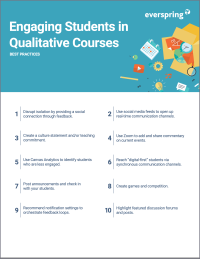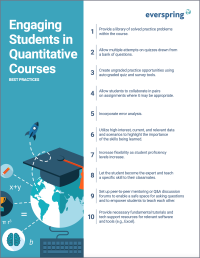Search
There are 16 results.
Tag
Tag
All (60)
Active Learning (2)
Activities (1)
Analytics (1)
Assessments (9)
Asynchrony (2)
Authentic Activities (3)
Backwards Design (1)
Canvas (3)
Case Studies (2)
Collaboration (5)
Communication (6)
Community (3)
Competency-Based Education (3)
Content Creation (4)
Copyright (1)
Course Maintenance (2)
Course Materials (1)
Course Preparation (4)
Discussions (3)
Diversity (1)
Equity (1)
Faculty Presence (1)
Faculty Support (2)
Feedback (10)
Formative Assessments (8)
Game-Based Learning (1)
Generative AI (5)
Grading (8)
Group Work (2)
Learning Objectives (4)
Multimodality (4)
Peer Review (1)
Presentations (1)
Qualitative courses (1)
Quantitative courses (1)
Revision (1)
Rubrics (3)
Scaffolding (1)
Summative Assessments (1)
Synchrony (3)
Third-Party Tools (2)
Workload (1)
Written Assignments (1)
Quiz Writing Best Practices
Quizzes are one of the most common forms of assessment. Instructors can use quizzes to not only test students but also check on their students’ progress throughout a course. When used effectively, quizzes can assess students in a variety of ways. This piece will provide recommendations and best practices for enhancing the quality of quiz content.
Quizzes for the Multimodal Course
From trivia games to final exams, quizzing tools have a variety of uses for learning as well as assessment. Exams and quizzes have a particularly plentiful range of possibilities in a multimodal or hybrid course, where they can be administered synchronously or asynchronously. Research suggests that the presentation of a tool influences student behavior in response to the tool. When comparing two student discussion boards, one an ungraded discussion and one a graded replacement for a final exam, Cheng et al. (2013) found that students displayed more knowledge on the graded board but more evidence of learning on the ungraded board. The students who participated in the study were more likely to grapple with new ideas when the stakes were low but more eager to showcase topics they were confident about when their responses would have a greater impact on their grades. When considering quizzing tools, we recommend allowing your course goals to guide your usage.
Rubrics as a Tool to Support Equity and Inclusion
While student populations have become increasingly diverse, many groups, including first-generation, non-native English speakers, and individuals with disabilities, still face barriers and bias that can derail their success in college (Super et al., 2020). Traditional grading practices—including penalties for late work, writing in dialects other than standard English, and even plagiarism— are prone to bias and only perpetuate disparities (Feldman, 2019; Savini, 2021).
Five Ways to Succeed as an Online Instructor
Whether experienced in or new to online teaching, following these tips on online instruction can make the process more intuitive. The online environment may seem vastly different from the classroom, but these tips will make it feel natural, allowing you to improve student experience, increase teaching efficacy, cultivate engagement, and ensure successful course management.
Easy and Essential Online Course Elements
Transferring your course online opens a world of possibilities. In fact, you might be tempted to spend hours trying to locate and learn new educational technologies, or to rebuild your entire course in the learning management system (LMS). But while effective use of technology can certainly enhance learning experiences, it can also introduce obstacles for both faculty and students.
Canvas Grading and Feedback: What Students See
Did you know that some forms of assignment feedback in Canvas are more obvious to students than others? Canvas has a Student View option for instructors to get a sense of what students are seeing in most general areas of their courses, but it can be challenging to determine what your actual students are experiencing when accessing your comments on their work or the rubric you’ve filled out for their submission.
Integrating AI Into Assessments: From Policy to Practice
Conventional assessments, such as essays and multiple-choice questions, have long been the cornerstone of evaluating student performance. However, the widespread availability of generative AI (genAI) tools necessitates rethinking assessment methods. Now that genAI tools are readily accessible and rapidly improving, it is crucial to develop assessment approaches that maintain academic integrity while leveraging the benefits of AI to engage students and prepare them for the modern workforce (Yu, 2023).










